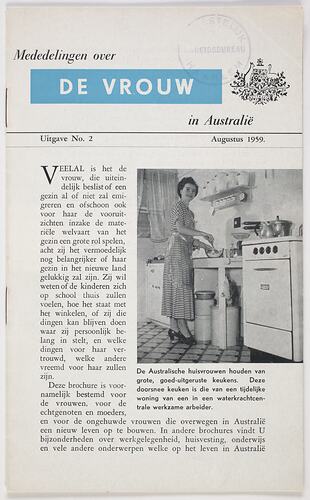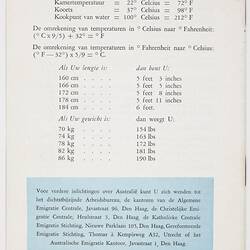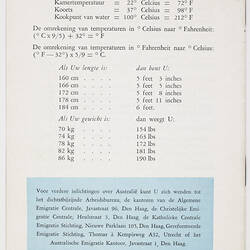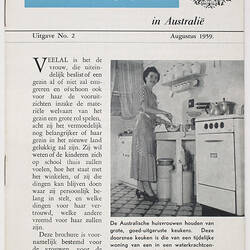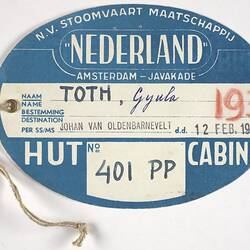Summary
Alternative Name(s): Booklet - The Woman in Australia.
Booklet written in Dutch, titled 'De Vrouw in Australie', it was published by the Commonwealth of Australia in August 1959. It is one of a series of information books produced by the Australian Government for prospective Dutch migrants and was used by Rinnert and Antonia Martina Pan, when they were deciding to migrate to Australia with their children.
Rinnert Pan was born in Friesland and Antonia Martina Van Hoorn was born in Rotterdam in the Netherlands. They married and lived in Heemstede. They had three children a girl, Mieke, and two boys, Jelle and Bart. The family migrated to Australia in 1962 under the Netherlands Australian Migration Agreement. Antonia did not pass the immigration medical at first, failing the eye test. However according to family legend, she redid the test, having memorised the eye chart, and passed. The Pan's decided to migrate to Australia because they believed Australia to be a more classless society than Holland. They were also attracted to the climate and the educational opportunities, and Rinnert was anti-war having been a conscientious objector during the Dutch war with Indonesia. He wanted to save his sons from future conscription as Holland had compulsory national service at the time. The family travelled on the ship Johan Van Oldenbarnevelt and upon arrival they were sent to Bonegilla Migrant Reception Centre in northern Victoria, and then to the hostels at Fishermen's Bend and Holmesglen in Melbourne, before camping on their own block of land at Homesglen until their house was built. Rinnert was a spraypainter by trade and continued this work in Australia. Antonia was a qualified black cross nurse (psychiatric patients), however her qualifications were not recognised in Australia and she ended up as a cleaner and nurses' aid.
Physical Description
A4 sized booklet with extensive black text in Dutch. The cover has a blue header with a black and white image of a woman cooking at a stove.
Significance
The post World War II period witnessed the production of a flurry of material which promoted, oriented and welcomed immigrants from the United Kingdom and Europe. This collection illustrates the proactivity of the Australian immigration administration and provides interesting insights into how officials wanted to sell Australia. This material directed at the Dutch market provides a comparison with what was being produced for the UK market, as well as enabling the exploration for motivations for migration.
More Information
-
Collecting Areas
-
Acquisition Information
Donation from Ms Mieke Alexander, 18 Feb 2002
-
Publisher
Commonwealth of Australia, Canberra, Australian Capital Territory, Australia, Aug 1959
-
User
-
Inscriptions
Printed on cover: Mededelingen over / DE VROUW / in Australie
-
Classification
-
Category
-
Discipline
-
Type of item
-
Keywords
Dutch Communities, Dutch Immigration, Immigration, Immigration Policies, Immigration Selection, Migration & Settlement, Promotional Materials, Settlement, Social Services, Social Welfare
